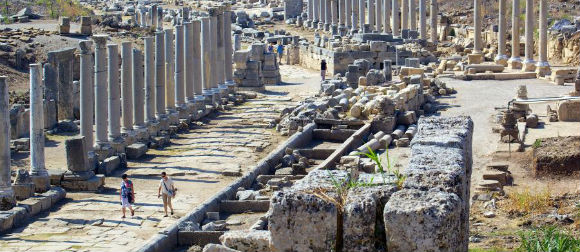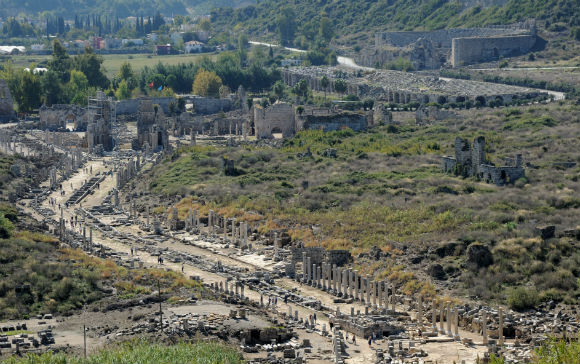The most impressive ruins of the Pamphylian coast are at Perge, at about 15 km east of Antalya. Perge was originally founded by the Hittites around 1500 BC. and was known as Parha. It was a successful trading centre near the Aksu (ancient Kestros or Cestrus) river when Alexander the Great arrived in 333 BC. He was welcomed in by the inhabitants and used Perge as base for his Anatolian campaigns. Alexander was followed by the Seleucids under whom the city prospered and Perge’s most celebrated inhabitant, the mathematician Apollonius from Perge lived and worked. Apollonius was a pupil of Archimedes and wrote a series of eight books on geometry. In 188 BC Perge became part of the Roman Empire during which the city flourished. Most of the surviving buildings date from this period.In 46 AD St. Paul started his journey in Perge (biblical Perga) and preached his first sermon here. Perge gradually declined during the Byzantine period, as the Aksu river silted, but remained inhabited until Selçuk times after which it became abandoned.
A visit to Perge starts by entering the archeological site through the Roman Gate, built during the reign of Septimius Severus (193-211 AD). Proceeding through the gate, to the right is the Agora or market place. This structure of 75 x 75 m dates back from the 2nd century AD. The center courtyard and shops were surrounded by a wide stoa, a covered walkway. The floor of the stoa and shops was made of colored mosaics. The agora was not only the centre of Perge’s trade, but was also a place for meetings as well as a forum for political, social, and philosophical discussions. The next building is the Hellenistic city gate that dates back to the 3rd century BC. This is certainly the most imposing building of the city and was cleverly designed to protect the city with its twin towers and its horseshoe-shaped courtyard at the back. It is thought that the towers had three floors and were crowned by a conical roof. In the year 121 AD, the horseshoe-shaped courtyard was rededesigned as a courtyard of honor. Behind the courtyard stood a triple arch. Around the arch there are about dozen inscriptions connected with Plancia Magna who lived in the 2nd century AD. She was the daughter of the governor, a priestess of Artemis Pergaia (Diana) and a benefactress to the city. Plancia Magna had the arch decorated with the statues of the emperors and their relatives.
After passing through the Hellenistic Gate and courtyard, one enters a broad, marble-paved double-colonnaded street measuring 300 meters in length that extends from the main gate to the acropolis. The street is 20 m wide and is divided in two by a 2 meter wide water channel running down the middle. At the end of the colonnaded street is the Nymphaeum, a triumphal fountain from where a stream flowed down into the water channel. The nymphaeum or nymphaion is an ornamental semicircular structure and dates from the reign of Emperor Hadrian (130-150 AD). A statue of a river god Kestros was located in the center of this huge fountain. Behind the nymphaeum is the acropolis with some remains of the Byzantine period. To the west of the nymphaeum are the remains of a palaestra dating from 50 AD and dedicated to the Emperor Cladius (41-54 AD).
Returning back to the entrance, there are the excavated Roman baths located southwest to the agora. Out of the site proper, is the horsehsoe-shaped stadium, the largest in Asia Minor, measuring 234 m by 34 m. The stadium had a seating capacity of 12,000 people supported by massive barrel-vaulted constructions. Just beyond the site entrance is also the theatre, which is of the Greco-Roman type and could seat 15,000 people. Unfortunately, it is for some time under reconstruction and unfortunately closed to visitors.
Perge,



Great but visit the museum after you see these ruins. There you will see the statues that were there
I think it was really interesting, but just be prepared that there's almost no shade so bring an umbrella or at least a hat. It's not really suitable for young kids due to the lack of relief from the sun/heat.
Be aware that the gift shop and tour companies are out to take your money. The prices are really unreasonable.
Another great place to wander & explore. Truly amazing place, the Romans & Greeks were so clever, just marvel at all that has been excavated. So many columns, walls, pillars, and still alot of work left to do. We enjoyed it so much.
very interesting, a must see historical place if you are in Antalya. It is better to see this place with just a driver and not those organized tours as you wouldnt have time to take pictures. We did hire someone who drove us to the places we wanted to see, just me and my family and did tour the place…
We went there in july 2011. on our own. We hitchiked from Antalya, no problem at all. We loved the place, very well preserved ancient ruins, both greek and romans. Dont forget about the heat and protect your head from the sun, and drink water. On the day we decided to go there it was over 40 degree. We stayed…
This was my second visit to this site, the Amphitheatre is still closed off to visitors due to restoration. However I did get a chance to have a look around the stadium this time…wow!
The main site is huge, well I suppose it would be if the town had a population of around 50,000. Most of the main Public buildings…
Those great towers as your enter the site are the just the beginning of the surprises you have visiting this place.
the size of the baths, the central alley….
Just amazing
This is a hugh site with on going restoration and excavation. The ampitheatre is closed at the moment but there is still loads to see. Visit Antalya museum to see the beautiful statues they have excavated. If your taking your Sat Nav, ignore it when you get off the D400 and follow the signs instead!!
This Location may be familiar to the people who used to visit the rmanents in the mideterrenian area. It is a nice place but it was strange that there was no entry to the theater which may be the main attraction there.
Today we travelled with my family to the ancient city of Perge. It is one of the first ancient sites or historical cities you can visit just outside of the city of Antalya. It is approximately 15 kms north east and is located on the Antalya-Side highway. And from the city center of Antalya and will take about 20 minutes…